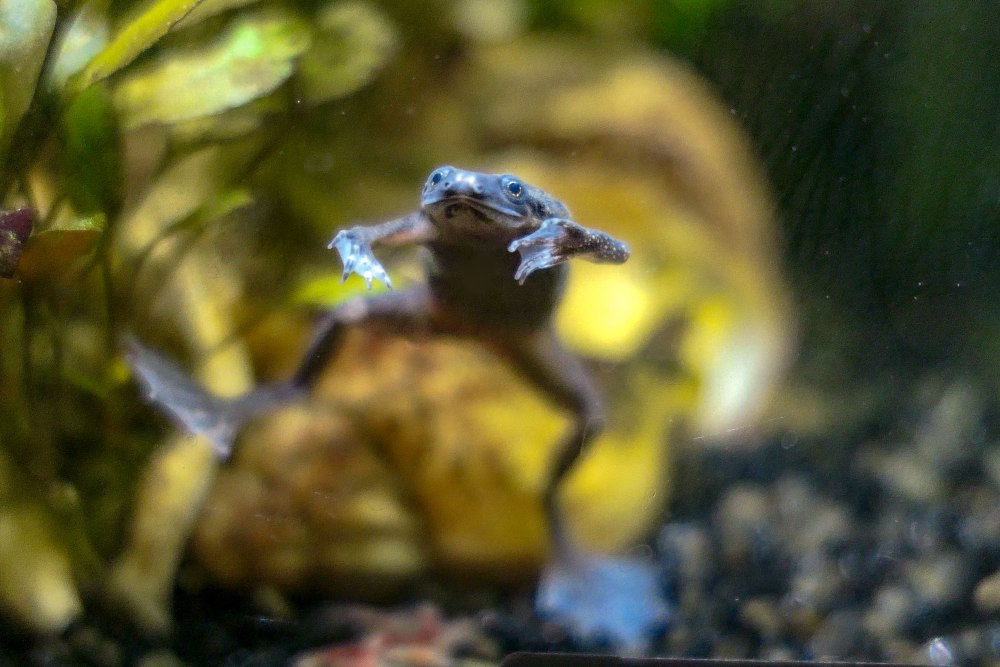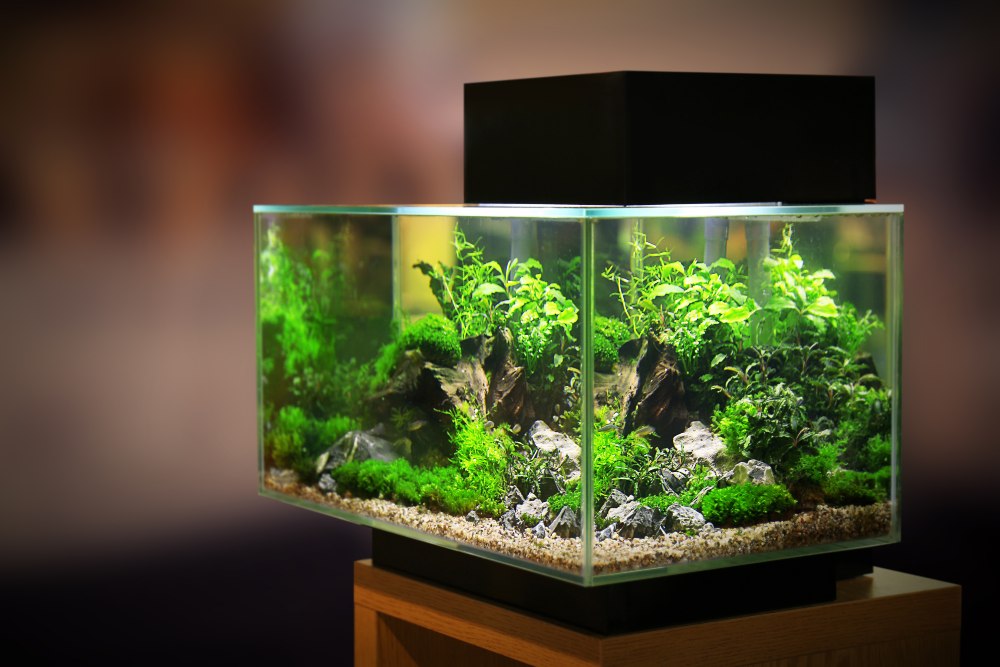Choosing tank mates for your betta fish can be a little daunting, especially since bettas are extremely aggressive and territorial.
But there are a few species that can get along with your betta fish, provided you have a large enough tank.
Since betta fish are sensitive to water parameters and aquarium conditions, you need to find a tank mate that matches the needs of your betta fish. And there’s no betta match than the African dwarf frog.
Here is a detailed guide that’ll inform you about keeping betta fish and African dwarf as tank mates.
African dwarf frog and betta and betta fish as tank mates: things to consider

As we have also mentioned before, betta fish aren’t very friendly to other aquatic specifies.
This solitary fish gets quite aggressive towards other fish and continues with aggression until the other fish dies. However, it tends to adjust well when the new tank mate is from a different species, like African dwarf frogs.
But to make the tank comfortable for everyone, you need to keep a few things in mind. Let’s take a look at all these conditions so that both the frog and your betta coexist happily.
Tank size
Tank size is the most crucial factor to consider while keeping these two species together. Bettas are coastal fish, and they are used to living in flowy streams, hence they won’t be able to adjust to a small tank.
Plus, when keeping your betta with African dwarf frogs, you must keep both these species in a larger fish tank. A water tank with at least a ten-gallon capacity is ideal for both species.
African dwarf frogs and betta fish are both custom to living in shallow rivers, ponds, creeks, river basins, and rice paddies; they can easily adjust in a large tank with enough room.
When it comes to filling your tank, you should not fill the tank to the brim with water since the African dwarf frog needs the surface to breathe. Frogs breathe through their lungs, not gills. Hence, they must come up from time to time. Don’t get a tank that’s too deep; otherwise, the African dwarf will struggle a lot to swim up each time it needs air.
A fish tank of around 12 inches tall is an ideal size, but that too has a risk. Betta fish tend to jump out of shallow water, and shallow tanks are no exception. Your frog can also jump out of the tank, which is quite dangerous.
If the dwarf frog remains outside the aquarium for more than twenty minutes, it won’t survive and will die of dehydration. To ensure both the betta fish and the African dwarf frog stay inside the tank, always use a lid to keep the whole tank covered.
Setting up your tank
Bettas and African dwarf frogs are native to coastal waters; hence they are used to living with a lot of live plants. Therefore, you should try to recreate the same environment inside the tank as well.
If possible, refrain from using sharp plastic plants since they can harm betta’s fins. Plus, bettas and African dwarfs prefer shady waters, so try keeping floating leaves and other plants. Bettas need a lot of hiding places; hence keeping live plants will serve that purpose as well.
To make the aquarium more comfortable for the frog, you can build caves and similar structures. The tank should have enough substrate like small pebbles and other decorative items to ensure that both the African dwarf frog and the betta fish stays engaged while inside the tank.
Water temperature
Another reason African dwarf frogs and betta fish are compatible tank mates is that they both have similar needs when it comes to water temperature. The African dwarf needs a temperature between 75 to 80 degrees Fahrenheit. The betta fish’s ideal aquarium temperature is also the same, so keeping them in the same tank won’t be an issue.
To maintain the ideal temperature, use a heater inside the tank. Also, place a water pump beside the heater to evenly distribute the heat and prevent temperature fluctuation. Unstable tank temperature will stress out the betta fish, leading to health issues.
Water parameters
Water parameters are another factor to keep in mind when you house African dwarf frogs and the betta fish together. Betta fish are very sensitive to water quality, so you have to ensure the parameters are according to its comfort; otherwise, it will experience skin disease and other health issues.
Bettas need a pH level of 6.8 to 7.5, and dwarf frogs need a pH level of 7. Your duty is to monitor periodically if the pH levels are stable or not.
You also need to monitor your tank’s levels of ammonia, nitrite, and nitrate.
The tank should have 0ppm ammonia levels, 0ppm nitrite levels, and less than 20ppm nitrate levels. You can use a testing kit to monitor the water parameters at least once a week if you want to see the dwarf frog and the betta fish healthy.
Feeding technique
Feeding betta fish and African dwarf frog together might be a little stressful. The feeding time of both species is different. While bettas are very quick eaters, dwarf frogs require more feeding time.
Both the African dwarf frog and the betta fish tend to get aggressive in their feed time. If the betta goes after the dwarf frog’s food, it might attack and injure the betta. Similarly, you’ll see an aggressive betta if the dwarf frog comes after its food.
Fights are quite common during feed time because bettas finish their food within a minute while the frog needs at least fifteen minutes. Once the betta fish finishes its portion, it tends to invade the frog’s food. If the betta fish gets too aggressive, the frog might go hungry.
Allowing dedicated space for bettas and African dwarf frogs will allow both to have their food in peace. (It’s not as hard as it sounds.)
African dwarf frogs love eating sinking pellet form, while betta fish prefer floating pellets. Therefore, try to feed African dwarf frogs and betta fish from two different tank corners and two different pellets. Also, bettas have upturned mouths, so they won’t generally pick up food from the bottom of the tank, unlike African dwarf frogs.
This way, both of them will have enough food, and they may not interfere with each other’s feedings. But bettas might create problems if they get done with their feeding fast and see the frog still eating.
The betta will swim to the tank floor where the dwarf is eating and try to steal its food. Again to prevent this, you may keep the betta fish confined in a floating container for some time till the African dwarf finishes its daily feeds.
Another issue you might face when feeding African dwarf frogs is that they have very poor eyesight, so they might not see the food particles. If your dwarf frog isn’t eating well, you might want to consider feeding it using a tweezer.
These are the basics you have to consider while keeping African dwarf frogs and betta fish as tank mates. But apart from these, there are other things you must know before you introduce these new tank mates.
How many African dwarf frogs can share a tank with a betta fish?

African dwarf frogs live with other frogs in their natural habitat, so keeping it only with a betta fish might depress the frog. Hence, keep at least one more frog in your tank can help keep your African dwarf frog happy.
You can keep more than two frogs as betta tank mates, but you must get a bigger tank for several frogs. A tank smaller than ten gallons will stress out the betta fish since it spends most of the time swimming, so it requires a bigger aquarium space, lack of which will make it more aggressive towards their tank mates.
What to do when the African dwarf frog and the betta fish aren’t getting along?

Generally, male bettas are more aggressive than females. If you are keeping a male betta fish with an African dwarf frog, seeing them fight isn’t that surprising. Female bettas are less violent than their male counterparts so try keeping the dwarf frogs with females.
Sometimes, things may get out of control, and at such times, the best thing would be to separate the two. Try keeping the betta in the quarantine tank for some time to calm them down. But if the fight persists, you can use a tank divider to ensure they don’t harm each other.
But if you feel the sight of the African clawed frogs is intimidating the betta, you have to keep them in two tanks.
Final thoughts
Betta fish and African dwarf frogs can adjust to similar environments and keeping them in the same aquarium may not be very daunting. However, everything comes down to how the two species react as tank mates. Bettas are not very social animals, and they can’t easily adjust around multiple fish or frogs.
Following the tips we mentioned about tank size, feeding technique, water quality, etc., will ensure the betta and the African dwarf frog coexist well in the tank environment.
